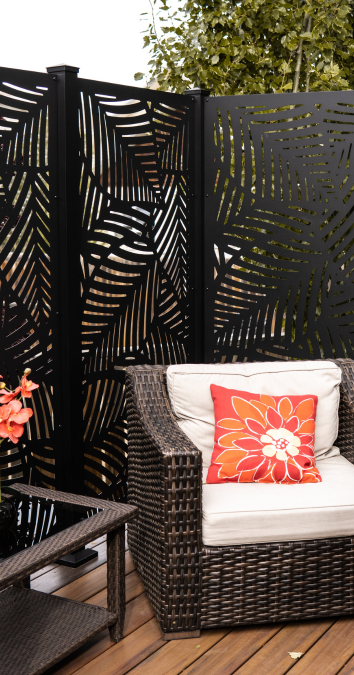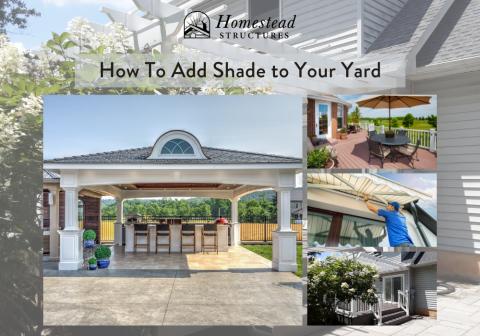Outdoor living spaces are increasingly popular in the U.S. In a 2021 survey, the International Casual Furnishings Association (ICFA) asked Americans their opinions on their home’s outdoor areas. Nine of every 10 homeowners said their yards were increasingly important. Meanwhile, 78% improved their patio, deck, yard, or porch during the COVID-19 pandemic and planned to make further upgrades in the future.
These spaces can improve your home but may be uncomfortable or limited if not properly shaded. Both direct sunlight and summertime precipitation can drive you indoors, but the right covering or natural sun blocker can ensure comfort regardless of the time of day.
Here are the areas that can benefit from shading.
-
Porches and patios
-
Decks
-
Play spaces
-
Barbecue areas
-
Outdoor kitchens
-
Picnic spaces
-
Pool decks and pool housesThe best option for shading outdoor living spaces depends on how you intend to use them, the time of day you are usually outdoors, and the amount of money you wish to invest in the improvements.
Here are the nine best options for adding shade to your outdoor spaces.
Add a Patio Umbrella
Permanent shading solutions can seem like a good idea, but sometimes simplicity and flexibility are a better option. Patio umbrellas can provide shade and allow you to remain outside during light rain.
The primary advantage of umbrellas is that you can put them up and take them down when needed. For instance, you might want to sit in direct sunlight in the early spring or late autumn. If it gets too bright, you can open the umbrella in a few seconds.
Also, if you are entertaining on the patio, you can open the umbrellas during the day and close them at night so guests can see the stars or enjoy the atmosphere created by your outdoor lighting.
Umbrellas do not cover wide areas, and you may need to adjust them throughout the day as the sun's angle changes. While you can fasten them to an anchor, they can lift and rattle in windy conditions. Nonetheless, they are a convenient solution in terms of flexibility and cost.
Use a Pop-up Canopy
Pop-up canopies are another flexible option. These structures use metal supports and fabric roofs and can collapse when not in use. When open and extended, canopies look like pavilions because they have a roof but no walls.
This shade solution is ideal if you need to cover a larger area. A canopy can provide enough space to set up multiple tables or give people room to engage in an activity without feeling crowded.
Some canopies have side flaps that you can take down when the sun shines at a low angle or when it starts to rain. They can fold for easy storage in a garage or shed, but the take-down process is more complicated than closing an umbrella. On the other hand, canopies have four supports. Though they are more stable than umbrellas, they can experience some lift in strong winds
Build a Pergola
Pergolas are unique structures with supports connected to the ground and rafters or latticework on the top. Though pergolas do not have roofs, they provide shade during growing seasons, as you can plant vines or other creeping or rambling plants that wind around the rafters.
Because you have a structure to guide the plant growth, you can get the best of both worlds: natural surroundings and shade. Pergolas can provide partial or full shade and offer better airflow than roofed structures.
You can build a pergola for different settings and purposes. It can cover a deck, patio, picnic area, or gathering space and shield a pathway or an in-ground pool deck.
Pergolas are typically square or rectangular, but other designs are possible. Materials like wood or vinyl are best for durability and design options. They provide more sophisticated and stylish shading than portable, removable options.
Put up a Shade Sail
A shade sail is a section of fabric stretched between several anchor points. You can use purpose-made supports, such as poles anchored in the ground, or rely on existing structures. For example, you might stretch a shade sail between anchors attached to your house and supports at the edge of your patio.
Shade sails can cover a larger area like a pop-up canopy, and you can unfasten them and take them down as quickly as a patio umbrella. However, you need strong fabric that you can stretch tight. It should be able to handle adverse weather and wind and withstand heat from solar gain and UV rays without degrading.
Install a Retractable Awning
A retractable awning has jointed arms and a fabric-covered frame. The system extends and retracts using a manual crank or a small motor controlled by buttons.
Awnings are permanently attached to a building or supports. Most models allow incremental adjustments, meaning you can set them to provide the needed shade without extending them fully.
With awnings, you can shade decks, patios, pool areas, and other outdoor living spaces without building a stand-alone structure. Many awning systems have a sloped top so that you can account for the sun when it is at a low angle.
You need to invest in awnings that can stand up to the elements and extend and retract repeatedly without failure. However, these shade-givers can be cost-effective if you want something more permanent than an umbrella.
Construct a Pavilion or Gazebo
Pavilions and gazebos are two of the more popular backyard structures. They provide more shade and protection than textile-based shades. Both these structures have roofs and supports and can protect you from precipitation and sunlight.
Pavilions are typically square or rectangular, with columns at each corner and a solid roof. They do not have walls. Though they can cover a patio, deck, or lawn, they do not have an attached floor. Gazebos, on the other hand, are round, hexagonal, or octagonal. They have a roof and supports like pavilions. However, they also have a floor and may feature partial walls and removable screens or windows.
Since these are stand-alone structures, they offer a lot of design choices. For instance, you could build a pavilion with vintage accents or a gazebo large enough to hold a dining table.
Build a New Deck
Decks can maximize outdoor living space while also providing shade. A deck off the second story gives you an area for grilling or lounging while providing shade for the patio below.
While a well-planned deck can double your outdoor living spaces, it also requires shade. Depending on the design, umbrellas or retractable awnings could provide solutions. You might also consider adding a pergola at the same time as you construct the deck. You can merge the two designs to create a unique space with integrated shading.
Hang Outdoor Curtains or Shades
Shading features allow you to use outdoor spaces comfortably in sunny conditions. Curtains and shades can provide additional coverage for your patio, deck, or backyard structures.
Curtains can hang from awnings, pergola beams, or the roof of a gazebo or pavilion. You can open these coverings for fresh air and natural light or close them to block direct sunlight and provide privacy or warmth.
Some outdoor shades can move up and down just like indoor window variants, while other patio or deck shades have frames and can slide side to side along tracks on the ground or ceiling. Many shade fabrics allow some sunlight to enter when closed, providing light without solar gain.
Plant Trees or Vines
Trees are excellent shade providers. The Department of Energy says that trees can reduce surrounding air temperature by 6 degrees by providing shade.
If you do not want trees around your home, you can consider other plant options. Vines climbing on a structure next to the house or over the patio can provide shade and let air flow through your deck or patio areas. Pergolas are the ideal structures for proving this type of shading.
More Tips for Maximizing Shade
You should consider specific needs and conditions when deciding on a shade-providing element for your outdoor areas.
-
Consider how much you are willing to spend and how much value the improvement can add to your property.
-
Find out where you need shade by noting the sun's angle at different times of day and seasons.
-
Measure the area you need to shade.
-
Define if you will use the outdoor spaces throughout the year or during specific seasons.
Finally, you should decide if you need new structures or if you can extend or enhance existing elements to provide the necessary shade.
Structures and shading features improve outdoor living spaces and can open the door to new outside elements. For instance, a new deck could add an area to socialize and relax while providing cover for an outdoor kitchen. Also, a gazebo with an electrical connection and Wi-Fi could function as a garden-side office.
Regardless of your intended use, shading elements will increase the comfort and usability of your outdoor living areas.

Facebook Comments Box